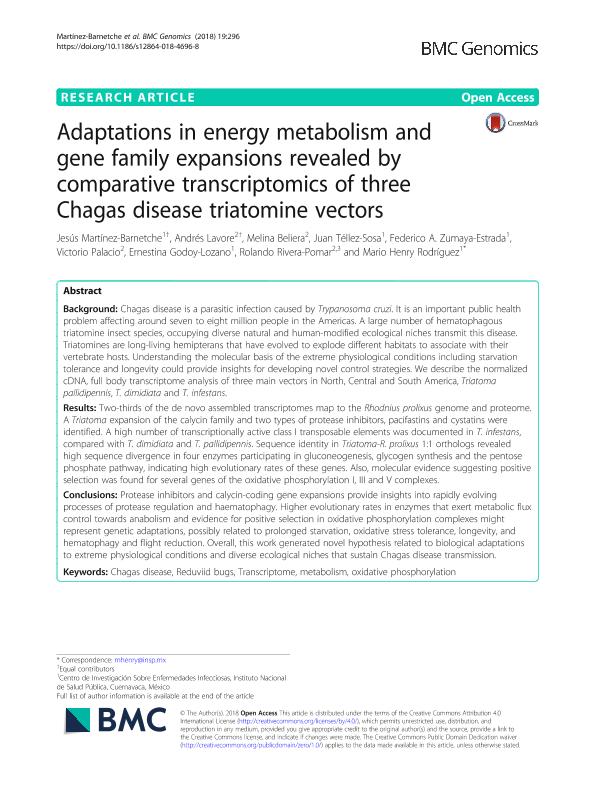Artículo
Adaptations in energy metabolism and gene family expansions revealed by comparative transcriptomics of three Chagas disease triatomine vectors
Martínez Barnetche, Jesús; Lavore, Andres Esteban ; Beliera, Melina Daniela
; Beliera, Melina Daniela ; Téllez Sosa, Juan; Zumaya Estrada, Federico A.; Palacio, Victorio Gabriel; Godoy Lozano, Ernestina; Rivera Pomar, Rolando
; Téllez Sosa, Juan; Zumaya Estrada, Federico A.; Palacio, Victorio Gabriel; Godoy Lozano, Ernestina; Rivera Pomar, Rolando ; Rodríguez, Mario Henry
; Rodríguez, Mario Henry
 ; Beliera, Melina Daniela
; Beliera, Melina Daniela ; Téllez Sosa, Juan; Zumaya Estrada, Federico A.; Palacio, Victorio Gabriel; Godoy Lozano, Ernestina; Rivera Pomar, Rolando
; Téllez Sosa, Juan; Zumaya Estrada, Federico A.; Palacio, Victorio Gabriel; Godoy Lozano, Ernestina; Rivera Pomar, Rolando ; Rodríguez, Mario Henry
; Rodríguez, Mario Henry
Fecha de publicación:
04/2018
Editorial:
BioMed Central
Revista:
BMC Genomics
ISSN:
1471-2164
Idioma:
Inglés
Tipo de recurso:
Artículo publicado
Clasificación temática:
Resumen
Background: Chagas disease is a parasitic infection caused by Trypanosoma cruzi. It is an important public health problem affecting around seven to eight million people in the Americas. A large number of hematophagous triatomine insect species, occupying diverse natural and human-modified ecological niches transmit this disease. Triatomines are long-living hemipterans that have evolved to explode different habitats to associate with their vertebrate hosts. Understanding the molecular basis of the extreme physiological conditions including starvation tolerance and longevity could provide insights for developing novel control strategies. We describe the normalized cDNA, full body transcriptome analysis of three main vectors in North, Central and South America, Triatoma pallidipennis, T. dimidiata and T. infestans. Results: Two-thirds of the de novo assembled transcriptomes map to the Rhodnius prolixus genome and proteome. A Triatoma expansion of the calycin family and two types of protease inhibitors, pacifastins and cystatins were identified. A high number of transcriptionally active class I transposable elements was documented in T. infestans, compared with T. dimidiata and T. pallidipennis. Sequence identity in Triatoma-R. prolixus 1:1 orthologs revealed high sequence divergence in four enzymes participating in gluconeogenesis, glycogen synthesis and the pentose phosphate pathway, indicating high evolutionary rates of these genes. Also, molecular evidence suggesting positive selection was found for several genes of the oxidative phosphorylation I, III and V complexes. Conclusions: Protease inhibitors and calycin-coding gene expansions provide insights into rapidly evolving processes of protease regulation and haematophagy. Higher evolutionary rates in enzymes that exert metabolic flux control towards anabolism and evidence for positive selection in oxidative phosphorylation complexes might represent genetic adaptations, possibly related to prolonged starvation, oxidative stress tolerance, longevity, and hematophagy and flight reduction. Overall, this work generated novel hypothesis related to biological adaptations to extreme physiological conditions and diverse ecological niches that sustain Chagas disease transmission.
Archivos asociados
Licencia
Identificadores
Colecciones
Articulos(CCT - LA PLATA)
Articulos de CTRO.CIENTIFICO TECNOL.CONICET - LA PLATA
Articulos de CTRO.CIENTIFICO TECNOL.CONICET - LA PLATA
Articulos(SEDE CENTRAL)
Articulos de SEDE CENTRAL
Articulos de SEDE CENTRAL
Citación
Martínez Barnetche, Jesús; Lavore, Andres Esteban; Beliera, Melina Daniela; Téllez Sosa, Juan; Zumaya Estrada, Federico A.; et al.; Adaptations in energy metabolism and gene family expansions revealed by comparative transcriptomics of three Chagas disease triatomine vectors; BioMed Central; BMC Genomics; 19; 1; 4-2018; 1-23
Compartir
Altmétricas



